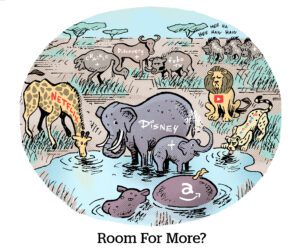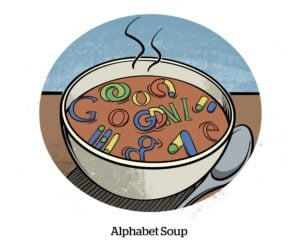During Friday night primetime nearly two weeks ago, the US women’s soccer team started its World Cup campaign with a victory against Vietnam. The broadcast drew more than 6 million US viewers, the highest ratings ever for a Women’s World Cup group stage game.
To get in front of those viewers, advertisers could pay about $60 to $65 CPMs for a direct deal with Fox Sports, which broadcasts the tournament in the US, or pay $40 to $45 CPMs in a programmatic direct deal with YouTube for unskippable 15-second spots.
Some advertisers were amazed to discover after digging into the prior weekend’s campaign reports that their ads had run on Fox Sports through YouTube TV during the US game. The CPMs cleared between $10 to $14, according to four CTV and video buyers at agencies and ad tech companies.
The skinny
This is no secret. Google Ads gets a portion of the inventory from TV networks and other channels that are carried by YouTube TV.
“Advertisers, and broadcasters in particular, likely don’t appreciate how much cable broadcaster inventory is there [in the DV360 auction] and is clearing at a quarter or less the price,” said one agency video investment leader.
There’s a general sense in the industry, he said, that inventory from big networks highlighted in upfront deals, such as HGTV or ESPN, or tentpole sports events like the Women’s World Cup, is wrapped up in the direct broadcaster sponsorships or the DV360 programmatic guaranteed deals, all at much higher rates.
But for now, supply exceeds what YouTube can sell at a premium to advertisers. Although Google hasn’t disclosed YouTube TV subscribers since Q2 last year, when it announced passing five million paying customers, it’s safe to say there’s been a major uptick in viewers in the past couple months. In April, YouTube announced $100 discounts on two popular NFL subscriptions, the core NFL Sunday Ticket lineup and the NFL RedZone show, but only for YouTube TV subscribers.
Last week, Verizon announced its mobile subscribers would get NFL Sunday Ticket free. Considering the $449 annual price for the undiscounted Sunday Ticket, isn’t that too good to be true?
Well, yes. Because that promo deal also requires a YouTube TV subscription.
So Google, all of a sudden, has a lot more legit TV in its CTV supply.
With linear cable, a viewer might see a local auto dealer ad at the end of a major sports broadcast because the regional distributor has a slice of the inventory, too. Instead, that inventory is now being served by the streaming distributor, Google.
“It’s a great deal for the marketer who now has YouTube targeting on this unexpected inventory, and a great deal for the consumer, who probably has something more relevant,” said Lee Baler, head of global strategy at platform ad-buying software company StrikeSocial.
Advertisers vs. Sponsors
CTV advertisers are getting actual TV-quality inventory. So, what’s the problem?
The advertisers, Google itself and YouTube TV viewers are all relative gainers from this scenario. Broadcasters, which go to great efforts to keep their inventory aloof from the general programmatic auction, may not be so happy.
Fox Sports believes the Women’s World Cup bestows great brand benefits on advertisers that appear during a game. Which is why it charges $60 CPMs for ads and holds YouTube TV to a relatively high minimum CPM to package the inventory for guaranteed deals.
But advertisers can place a large DV360 campaign on general CTV inventory and expect a mid-to-high single digit percent of the media to appear on well-known broadcasters within YouTube TV, including high-end live sports they would expect to come at a very high premium.
“YouTube TV makes up an extremely small fraction of auction campaign spend,” a YouTube spokesperson told AdExchanger. “Any suggestion that advertisers will obtain a meaningful amount of inventory on YouTube TV through auction buys is misleading and ultimately detrimental to advertisers who want to reach viewers through this inventory, as there are no guarantees that any amount of auction inventory will run on YouTube TV.”
YouTube’s point is that DV360 CTV auctions may bring some Bravo, NBC or even primetime Women’s World Cup into the mix, but it isn’t a way to deliberately buy those audiences. A DV360 advertiser that ends up with some Women’s World Cup spots isn’t going to have their brand associated with the event, like a real sponsor would, and could end up with none at all.
The advertiser side
Even if an advertiser did want to target Fox Sports on the cheap, there are no ways to dial up that inventory in the DV360 general auction. The advertiser is still stuck with whatever lucky dip they end up with from the time the campaign ran.
On the other hand, even “an extremely small fraction” of DV360 auction spend is a massive number. That’s why this inventory falling through to the auction is being noticed by advertisers.
This is a situation that sports leagues especially have dreaded for years. That $12 YouTube TV CPM on a Women’s World Cup ad is an uncomfortable mirror for Fox Sports and for FIFA, said one agency TV and sports sponsorship buyer.
While some advertisers see hidden diamonds in the YouTube CTV supply, which also includes random YouTube accounts and cruddy channels that are the equivalent of made-for-advertising sites on the web, others just want YouTube’s targeting.
“It may seem counterintuitive, but we have a couple brands trying to figure out how to avoid it,” said one agency buyer. Some advertisers like YouTube CTV for the relatively cheap reach, she said.
A primetime TV Women’s World Cup ad clearing for $12 CPM seems like a steal when a sponsor pays the broadcaster five times more for the same spot. But for a general DV360 CTV buyer that wants to reach audiences for $8 or $9 CPM, those Fox Sports or ESPN ads actually drive prices up quite a bit.
“Some advertisers don’t care about the prestige element of appearing on ESPN or Bravo,” said the same buyer. “They care about targeted reach at a lower CPM.”
The big question
The fact that Women’s World Cup ads are showing up in the general DV360 auction in a consistent, although fractional way raises an important question for YouTube.
Will the same premium inventory show up once the NFL season starts?
September begins the NFL season, the first where YouTube will own the NFL Sunday Ticket league distribution deal.



















